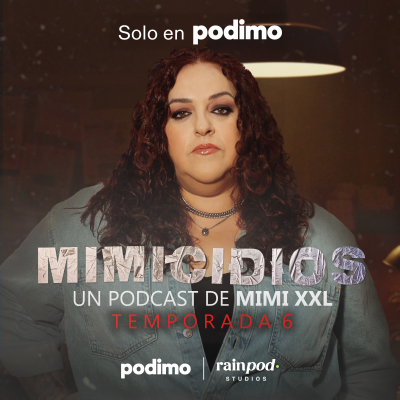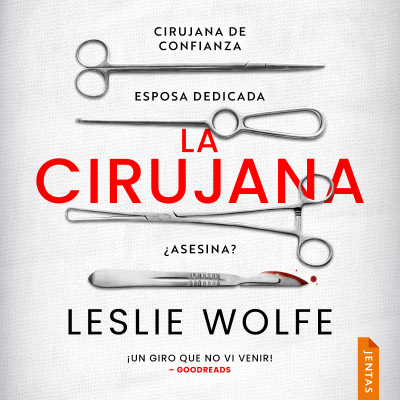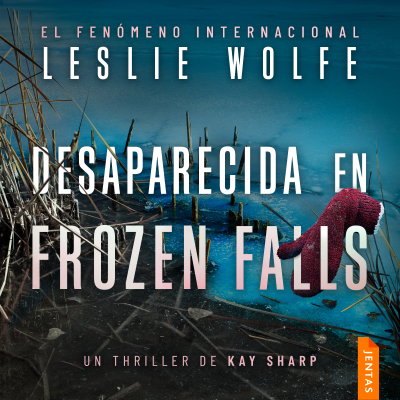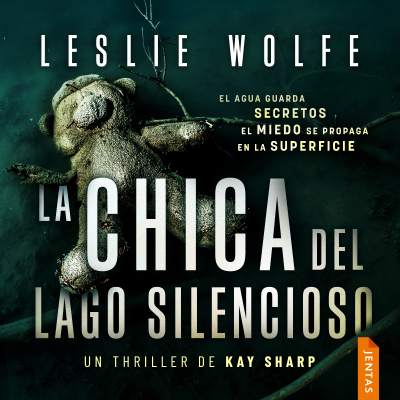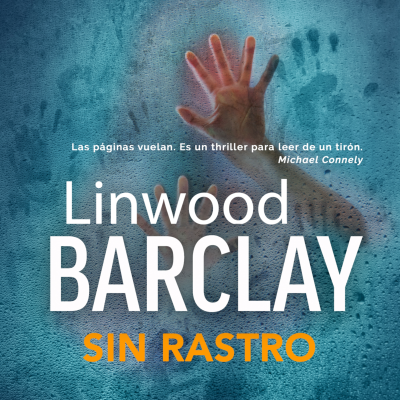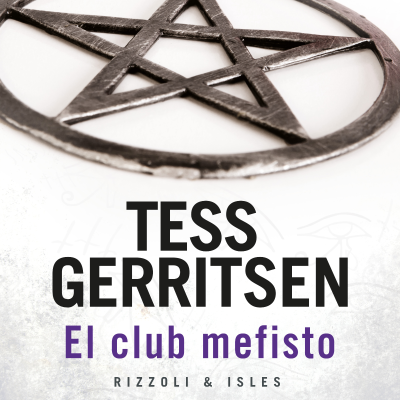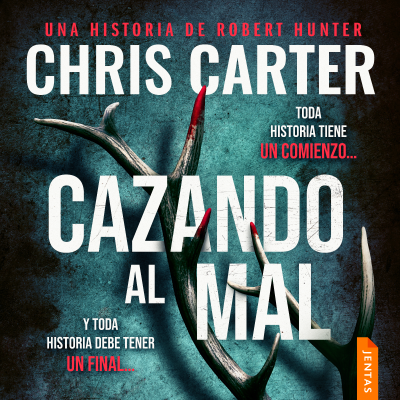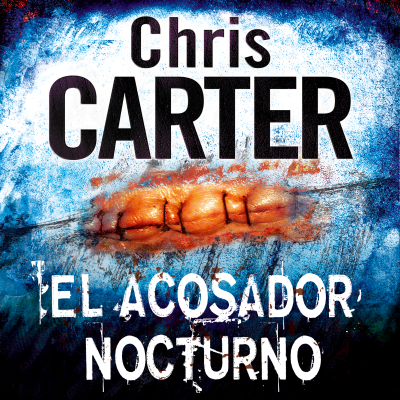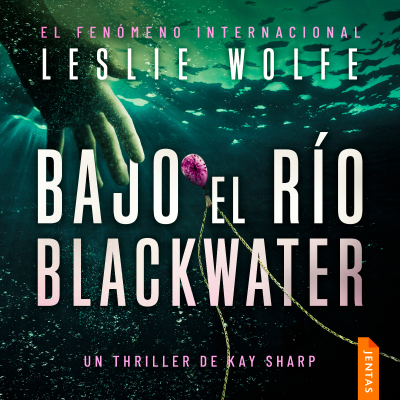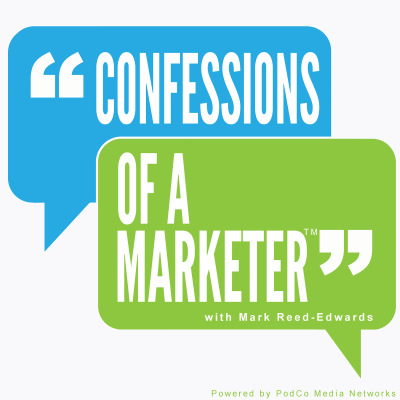
Confessions of a Marketer
inglés
Negocios
Disfruta 30 días gratis
4,99 € / mes después de la prueba.Cancela cuando quieras.
- 20 horas de audiolibros / mes
- Podcasts solo en Podimo
- Podcast gratuitos
Acerca de Confessions of a Marketer
In each episode of Confessions of a Marketer, Mark Reed-Edwards talks with a marketing leader or thinker about the deepest challenges in our business. Luminaries such as Beth Comstock, Whitney Johnson, Jacques van Niekerk and more share their wisdom with Mark. The podcast is a must-listen for marketers around the world and has ranked consistently among the top-rated business and marketing shows.
Todos los episodios
234 episodiosInsights on the Brink
Mark Reed-Edwards: I'm Mark Reed Edwards. Welcome back to Confessions of a Marketer. Today, I'm joined by Tim Hoskins [https://www.linkedin.com/in/tim-hoskins-quester/] and Brett Townsend [https://www.linkedin.com/in/brettrtownsend/] of Quester [https://www.quester.com], an insights and strategy company that specializes in human conversation. They've just released a new book called Insights on the Brink: Revitalizing the Market Research and Analytics Industry [https://www.amazon.com/Insights-Brink-Revitalizing-Research-Analytics/dp/B0DC5RD2KX/ref=sr_1_1?crid=17WW5SUWY9CCR&dib=eyJ2IjoiMSJ9.MmrMQHBmOQBnW1heHgNoId0OefNIJzm_Xy5NbwQvQOE8l27uML5xepbvi4oyUxOkGY8BIJqoFlJzIsIeDiN3wOCZG8AQVtR98LS4HZQ32BJ6CBfgg8BFvV-A0jb9IHdykdd86IbYxMn16eRXxwrcBY-xEpgdGOl4M5tyHw26TB1RC2ztonh3e2ddOorwLbsz4i4MuFjad6FS5UtuPxjzDsKYypO7hzKvZk3QxSCcRmo.ooAdGxQz8yeF7zkmwIKL1fZdhUhuQoo-1jLqnF9PwNY&dib_tag=se&keywords=insights+on+the+brink&qid=1727387017&sprefix=insights+on+the+brink%2Caps%2C152&sr=8-1]. As someone who has worked in and around analysts and market research for a long time, it's a subject near and dear to me. Tim and Brett, it's great to have you here. Brett Townsend: Thanks, Mark. Mark Reed-Edwards: Can you share your backgrounds and how you both ended up at Questor? Tim, maybe we can start with you. Tim Hoskins: I came from the information security space and worked at a startup for several years and then made the jump over to quest or to lead their sales and marketing and about four years into the job, I was grateful to be promoted to president and then acquired the company in 2022. Mark Reed-Edwards: Brett? Brett Townsend: Yeah, I started my career on the agency side and then spent 15 years in corporate insights where I was a client of Quester's for 10 to 12 years, going back to my early days at PepsiCo and Tim and I became good friends over the years of being a client together and always kind of had this conversation, this ongoing conversation, about if I ever wanted to leave corporate, how it would be great to work together. And so we made that happen about two years ago. Mark Reed-Edwards: So, Brett, can you tell me, exactly what Quester does? Brett Townsend: Well, I think we both could definitely take this one, but we are a branding and innovation strategy consulting firm where we work with a number of clients on: How do they build their brands? How do they innovate, properly, more effectively? And we really focus on consumer narratives and what are those stories behind the research that are really driving decision making? And then we layer that in with a number of different things. So it's a very holistic consulting type of view where insights are the backbone of what we do, but we're not a full service agency, so to speak . Insights gives us the tools to help consult our clients on a number of different things, whether it's jobs to be done, demand space work or whatever. But at the heart of it all are these consumer narratives and really helping people tell better brand stories and, and create very meaningful, long lasting innovation. Mark Reed-Edwards: So has it been the dream come true that you thought, leaving corporate life and working at Quester? Brett Townsend: It really has been, you know, I mean, it's been fun to work together with Tim finally, after talking about it all these years and just being back on the agency side, after being on the corporate side for so long, I really have a lot of empathy for what our clients go through and what they face. And so it's really led to great, meaningful conversations where we're really able to help our clients in a way that's very beneficial to them. Mark Reed-Edwards: So Tim, I'd like to ask you about this book that just came out. What prompted you to write it? Tim Hoskins: Well, it all goes back to just a number of conversations that Brett and I had had through the years about the industry and the state of the industry and where it needs to go. And I've had the fortunate opportunity to be a co chair of the Insights Association's largest conference, the Corporate Researchers Conference. And one day I called Brett and I said, "Hey, you should be a keynote and take all of the things that you believe in your heart and that we've talked about and get up on stage in front of hundreds of people and just kind of have a drop the mic moment." And so that's where it started. And I think that Brett received a lot of accolades and feedback. And it was some of those attendees in the room who said, "you should put this into a book." And when he joined Questor, he started talking to me about it and I said, Why not? Let's do it. And about halfway through the writing process, Brett called me up and he said, "Hey, I'd love for us to write this together." And to not only bring together his client side experience, but also my agency experience. And so he wrote the first draft and we sat in a room for three straight days with a colleague of ours and we went back and forth and rewriting and the final version is definitely a labor of love and something that we're proud of, but our real goal is, is to just spark conversation. Not everyone might agree with everything that we've written, and that's okay. The purpose is to spark the conversation, and to potentially create behavior change so that we can revitalize our industry. Mark Reed-Edwards: Yeah, I want to talk about the book a bit and maybe we can, you know, kind of tear it apart in a moment, but Brett, I'm wondering what you learned in drafting this book that maybe you didn't expect. Brett Townsend: Wow. That's a good question. Wow. The reason why I'm hesitating is because I think it turned out mostly the way I expected it would. As Tim was saying, this is something that's been kind of an ongoing decade long conversation that the two of us have been having and just things that we have both experienced through the corporate side or the client side. Conversations that we've had with others, just observations we've made, you know, both Tim and I served on the, the board of directors for the Insights Association. So it gives us a lot of visibility to the industry as a whole. And so the book really is just a compilation of each of our over 20 years experience in the industry and things that we've done. The only thing that might have been a little different than what we set out doing at the very beginning was maybe some of the structure, areas where we emphasized or de-emphasized. In fact, the chapter on human emotion looks very different than the original version that we wrote because as Tim said, as we were locked in that room together, we realized that we needed to take another direction with it. And so we did that. And so with few exceptions, it's turned out the way that I thought it would. Mark Reed-Edwards: So let's talk about the book and maybe Tim, you can start. Can you tell me how it's organized, what a reader is going to get out of it and maybe some of the highlights of the book. . Tim Hoskins: The first chapter, the intro, is really just a historical, kind of how did we get to where we are and really setting the context and some of the challenges that we face within the industry. But the rest of the book is meant to be inspirational and also provide very specific tactics and strategies to implement everything from what Brett was talking about: emotion to storytelling, to influence. The intent and the goal is for a reader to walk away and have practical ways to apply this in their day to day lives-- how to ultimately drive top and bottom line growth for their organization. And then the last chapter is one that I'm incredibly proud of. It's something that Brett really took the focus on writing, and that is a call to action for senior executives in these large organizations, because ultimately the senior executives set the culture. The culture of how we view empathy, how we view consumer behavior, and whether or not we choose to listen and be humble to what consumers are providing as feedback, or to say that we know better. We hear this consumer centricity a lot as a buzzword within a lot of different publications. But are we really living it? And it's really a call to action for senior executives to not only say it, but live it and to support it throughout the organization. Mark Reed-Edwards: Brett, you and I were chatting before we started recording and we were talking about market research and the way it's sometimes just dumped on people's laps, right, in a presentation. So, following on what Tim was saying, how do you present data? How do you present insights to an executive in a way that they will then understand what the next step should be or present it in a way that is just clear. Sometimes it's just data, it's charts, and there's no conclusion. How do you present that conclusion? Brett Townsend: Well, the easy answer is that I don't present data in the traditional sense. You know, our brains are not wired to remember numbers, but we are wired to remember stories. And usually when I am meeting with a CEO or senior executives in my career, I've had maybe 30 minutes, sometimes longer, but a lot of times I have 30 minutes to go in there. So I'm not going in there talking about methodology. I'm not showing a bunch of numbers. I'm getting to the point. And I think one of the things that we have in the book is a saying that I've used a lot. It's: "I don't need to know everything, I just need to know what I need to know." That's what I would tell the agencies when I was their client. But then the same goes true as I go up the ladder. And so, you know, my CMO doesn't need to know as much as I know. The CEO doesn't need to know as much as I know. They just need to know what are the insights, what is the conflict we're trying to overcome and what am I recommending to go do it? And it's really that simple. And I do it in the form of compelling stories that they can relate to where they feel empathy for the consumer. And then always a call to action or something that can go be acted upon . At the end of the day, we can give great insight and tell a great story, but if there's no call to action or direction at the end, then it's just story time at the library. So we have to really make sure that we're telling these senior executives what we feel they should go do, because they want to hear that from us. You know, they want outcomes. They want direction. Now it's up to them whether they choose to follow it. And that's happened sometimes where they don't. But when I go in there with a concise story, clear insights and a clear direction on what to go do, they love it and appreciate it. And most of the time they agree. And then we go forward from there. Mark Reed-Edwards: So my next question kind of rises out of that: Why does the industry need to be revitalized? Tim, maybe you can start and then Brett, maybe you can follow up. Tim Hoskins: Brett gave this great quote in the book that I wholeheartedly agree with. And that is, is that every department within an organization should want to work with insights. Theoretically, we should have no natural predators and provide a level of depth and nuance about consumer behavior and understanding that they should be clamoring over. And yet that's not the case in all organizations and in many organizations. And that is the real challenge. And we actually control our ability to turn that around. And that's part of the reason why we think it needs to be revitalized. I think that you can look at other stats and figures in terms of marketing and messaging campaigns that don't resonate, innovations that fall flat. Perhaps that's because we didn't have a visceral and empathetic understanding of the consumer's circumstance: their needs, their wants, their desires, and their emotions. Brett Townsend: And then, I'll piggyback on that. The revitalization also comes with this mindset change where we have to realize that we are not clinicians and academics. Our job is not to conduct methodologies. This revitalization would take place as an evolution to understand that, A lot of the techniques and things that we use now were developed by people who did not work in business, who were not responsible for business results, who weren't held responsible if something didn't work because they weren't in charge of developing a product or increasing sales. We are in a very disruptive environment with mergers and acquisitions and new players coming into the market. And the barriers of entry have been practically removed from most categories. And there's so much going on now that we have very specific demands from our employers and from senior leaders that desperately want things from us that as an industry, historically, we've not consistently given them. And so this revitalization is this understanding of who we are, the power we have, and how we need to go about doing our jobs in the most effective way possible. Mark Reed-Edwards: You used the word "empathy" quite a bit. And I think it's an interesting word to use in a world dominated by data points. That those data points actually represent human beings. Right? And injecting empathy into the way in which we examine that is really key because you know, people do make brand decisions for visceral reasons. They have a love for a brand like Apple or Amazon or, you know, whatever it is. And that's why they make those decisions and that doesn't necessarily show up in data points. Tim Hoskins: Absolutely. And we know, based on neuroscience work, that emotion drives a majority of the decisions that we make--whether conscious or, or unconscious--on a daily basis. But yet I don't believe that we're always taking that into context. When we're viewing decisions and specifically data. We love data. The fact that the data analytics world has become so important within organizations and, is, is in many ways been democratized, is phenomenal for our industry and for organizations. But the difference is that you can't just stop at that data. You have to be able to understand the "why." Some of the best companies that we work with leverage the power of the data analytics and they marry it with the empathy and the "why" from consumers to help build their strategies. And it's the one-plus-one that equals three. And right now we see a lot of companies, it's either one or the other. Rarely are we seeing where it's a complete mix and compimentary. Mark Reed-Edwards: That's fascinating. So, let's maybe get to the payoff for all this. How can brands most effectively use analytics and market research to further their cause? Brett, maybe we can start with you. Brett Townsend: Well, starting with what Tim said, don't make it an either or proposition. We need data and we need historical data and we need predictive data. But to your earlier point, there is no empathy in data. There is no emotion in data. And it is up to us on the market research side to marry the historical and predictive analytics with this empathetic storytelling that captures the emotion that the consumer is facing. Mark, it's not an issue of choosing to go data or consumer insights. You know, we hear there's a lot of companies that say we need to be more data driven, and usually that means, oh, we got to. Do more analytics and we're going to kind of get rid of traditional consumer insights and really what that's supposed to mean is that we stop making gut decisions. We stop listening to the loudest voice in the room or the senior most person in the room just because we're deferring to him or her. We need to make decisions that are consumer centric decisions. And you know, in great qualitative can be data. And so I think that's kind of understanding what that term "being data driven" really means. It doesn't mean just be numbers. But then it's also taking the responsibility of being consumer centric out of only being consumer insights' responsibility. Make it the responsibility of the whole organization. I mean, this is something Jeff Bezos said: this customer obsession that Amazon started with and still has. It's everybody's responsibility. And in most companies, it's really only the responsibility of consumer insights, and to a lesser extent marketing. But I think the more marketing can work with consumer insights and take on that responsibility of consumer centricity, then you really start to see magic happen. And that's when you start to see very meaningful stories coming out of marketing where the consumer conflict is not only addressed, but resolved in the way that that brand is helping the hero or the heroine of the story, overcome their conflict. And it leads to great innovation. It leads to great relationships with retailers because you're selling in stories that are going to help sell things in those retailers. It's this big ecosystem of consumer centricity that when everybody's pitching in and everybody takes it as their responsibility, it works so well. Mark Reed-Edwards: Yeah, consumer centric rather than data centric. Brett Townsend: Or product centric. You're right. It's both. It's both. It's not being data centric or product centric, but being consumer centric, because then you're not worried about numbers or you're not worried about products. You're worried about solutions. Like if you really have empathy for you know, a low income consumer who has to decide whether or not to pay the electric bill or buy food for their family, then you really start to decide, okay, it's not that they need a product. We need to come up with a solution to help them. And it's, that's that kind of feeling that we need to have. Tim Hoskins: You know, one of the most popular things that we talk about with our clients-- and it usually happens at the front end of an initiative and then right before we're actually getting ready to take them through the story-- we sit down with everyone in the room and we talk about the power of narratives. And narratives are formed and drive consumer behavior. But narratives are formed through stories. They're stories that we listen to every day or allow ourselves to listen to. They're stories that we seek out. They're stories that we actually tell others. Those stories at mass, create narratives that explain behavior. But what's really important is, is that stories and narratives can be true or false, fact or fiction. But that doesn't matter. It's all about the context of how the consumer got there themselves or with others. And if we look at data, we look at insights, and we look at stories, we have to be able to do so in a way to where we see them as sacred, right? Whether we agree with them or not, it's not to walk in and look at it and poke holes in it. It's this deep seeking to understand. And, you know, when we set the context in our presentations, it's a very interesting moment where, when somebody starts to ask a question or they start to think through things, once they've shifted their mindset into the power of narratives, then they start to look at the information from a whole different perspective. It's a challenge. It's not easy, right? Because we all have our biases and we bring them with us every day, but we have to leave those at the door and really be open minded to understand people as people. Mark Reed-Edwards: People are people. It's a good thing to keep in mind as we stare at our computer screens all day long. Thanks for joining me for this great discussion, Brett and Tim. I really appreciate it. I'm assuming people can get "Insights on the Brink" on Amazon or any of the other online sources. Brett Townsend: Yep, just go to Amazon and do a search for "Insights on the Brink" and you'll find it there, available both ebook and paperback. And we also have a link on our website at quester. com as well. Mark Reed-Edwards: Awesome. Thanks, guys. We'll see you on the next Confessions of a Marketer. Links: * Insight on the Brink page on Quester's website [https://www.quester.com/insights-on-the-brink/] * Insights on the Brink purchase link on Amazon [https://www.amazon.com/Insights-Brink-Revitalizing-Research-Analytics/dp/B0DC5RD2KX/ref=sr_1_1?crid=17WW5SUWY9CCR&dib=eyJ2IjoiMSJ9.MmrMQHBmOQBnW1heHgNoId0OefNIJzm_Xy5NbwQvQOE8l27uML5xepbvi4oyUxOkGY8BIJqoFlJzIsIeDiN3wOCZG8AQVtR98LS4HZQ32BJ6CBfgg8BFvV-A0jb9IHdykdd86IbYxMn16eRXxwrcBY-xEpgdGOl4M5tyHw26TB1RC2ztonh3e2ddOorwLbsz4i4MuFjad6FS5UtuPxjzDsKYypO7hzKvZk3QxSCcRmo.ooAdGxQz8yeF7zkmwIKL1fZdhUhuQoo-1jLqnF9PwNY&dib_tag=se&keywords=insights+on+the+brink&qid=1727387017&sprefix=insights+on+the+brink%2Caps%2C152&sr=8-1]
How To Love Your Customers So They Love You Back
I'm Mark Reed Edwards. Welcome back to Confessions of a Marketer. This week, we have Ben Afia, who describes himself as a consultant, speaker, and author who's had his fill of cold corporate organizations treating their employees and customers like robots. So his mission is to make businesses more human. And to that end, he has a new book out called The Human Business: How to Love Your Customers So They Love You Back [https://benafia.com/book]. I've known Ben probably for about 15 years. We've worked together and he's been on this podcast a number of times. Transcript Ben, it's great to have you back. Ben Afia: Thank you very much for having me on, Mark. It's a pleasure. Mark Reed-Edwards: For those people out in the audience who don't know you, could you just sketch out your career history and how you came to write this book that I'm holding in my hands? Ben Afia: So I started specializing in language at Boots, the chemist in the UK. In that role, I was working in brand strategy. And looking in particular at the voice of the brand and managing copywriting across the business. But I got made redundant about 20 years ago, decided it was time to go solo with a new baby on the way and about to move house, it was the perfect time to start a business. And so it turned out to be so my Boots colleagues went off to various places and encouraged me into companies like Eon, Barclays, Legal and General, and so my freelance career went from there. And I started as a copywriter specializing in brand tone of voice. But clients very quickly were asking me to extend that. So we were looking at the language and this is the language that people might be using in the marketing team, writing communications, but also the language in customer service and throughout the business, indeed. And so we were asked to train people in writing skills, but also in spoken empathy skills. So when the contact center people are on the phone with customers, they are speaking and then confirming things in writing. So that started to extend the work that we were doing. And very quickly, I realized that really what we were doing was change. So I started looking, this is probably 15, 16 years ago when we first worked together, probably thinking about how do we help this change to stick? How do we get the right behaviors throughout an organization? And for me, the change really stems from the brand, from the brand strategy, your vision, purpose, values, behaviors. It's all an extension of the behavior on the front line. So that all of these things join up. And I ended up realizing that really I was working on three things. I was looking at the culture or the employee experience. I was looking at the brand or the brand strategy. And I was also looking at the customer experience. So that's what I ended up trying to pull together in my book because I just needed to organize that thinking in a way that might make sense to the companies that I was working with. And the insight that had come to me was that. Unless you align your culture and your brand, you can't possibly give the experience to customers that you hope. Or that they hope to receive because you end up promising through your marketing, things that you can't deliver through your service. And the only way to join those up is to align culture and brand. Mark Reed-Edwards: And there's nothing more disappointing than to see some kind of marketing campaign that says, you know, our store is a great place to visit. And you go there and there's a disconnect between what you see in their marketing and what you experience. And so what you do is you kind of connect those two. Ben Afia: Totally. A few years ago, I was running a workshop. I had 40 customer service people and the company, who will remain nameless for the moment, had just launched their new brand strategy. So they had a new strapline, a new campaign, and this had gone public. So I had 40 people in customer service in this workshop. And I said, what do you think of your exciting new strategy? 40 faces just looked at me blankly. Nobody bothered to brief them. And this is the disconnect I'm talking about. You know, if you're going to send messages out to your customers, the first people they're going to talk to in your stores, in customer service, they need to know all about it. They need to be briefed. They need to be trained. They need to be ready to deliver that service, to deliver that promise. Mark Reed-Edwards: Many companies think of the brand as just a visual thing, right? So, we redesigned the website, we have a new logo. And maybe a new strap line or something, and maybe some new brand language, but that's kind of where it ends. And it's a top down procedure. I know when you and I worked together, I think about 15 years ago, that project, the verbal identity, tone of voice, rose out of us doing a revamp of the way the company looked. And it became really evident that we needed to not just put a lick of paint on things, but to actually reengineer the way we talk to employees, the way employees talk to customers and partners and so forth. And that's when we called you in and it was maybe the most effective part of the brand revamp that we did because we had to go and enlist people. When you ask people to talk differently, to use different language, you have to train them and you have to engage with them. And that's what we ended up doing. And I think maybe that's why that brand was more successful than it would have been otherwise. Ben Afia: I think that's right because what happens when you ask people to talk differently or write differently is you're actually encouraging different behavior. Because really the speech is only a reflection of the underlying behavior. So the way I think about this is, and the way that I encourage change now is by recruiting a team of champions from throughout the business. So for example, I worked with Aldermore Bank in the UK, the mortgage business. They felt that they were delivering good service and their brokers and their customers were saying so, but they were getting complaints when they confirmed things in writing. And so by recruiting a team of champions, somebody representing every team in the customer journey, we were able to hear from the whole organization and sense and make the connections throughout the customer journey. So from every touch point, every point of contact a customer experiences with the company, we can affect those and we can connect them up and align them. And what very quickly happens when you recruit this team of champions is they make connections and it reveals for them that there are problems in the process, that things aren't quite lining up in the process. But of course this gives them the opportunity to fix it. So this is what I mean by changing behavior. It's the behavior of the organization, the systems and the processes. It's about redesigning them. So that rather than just trying to rewrite letters, which is, I suppose, what you might perceive a rebrand to do. In fact, what we're doing is we're changing the systems, the processes, and therefore the culture. So to me, brand is absolutely, brand is the organization. I think Seth Godin said, "Marketing is everything a customer experiences." Well, a customer experience is everything that you do. So we are all responsible for marketing. We are all responsible for the brand it runs throughout our organization. It's as much the responsibility of the legal team as the branding team. Operations, compliance, you know, whoever, are all making decisions that affect things that customers experience. So all of those people, we have to involve them. Mark Reed-Edwards: Yeah, I mean the back end, how you sign up customers, how you sign up partners, the language you use in your contracts there are obviously some bits of language that you have to use. But you can make your contracts a bit more friendly. You can make the experience for the partner portal more friendly and have it match the experience you say people have with your company rather than just having what you say and what you do be separate things. It's integrating that brand because you know, as you say, the customer, or the partner, or, you know, the person off the street who just comes on your website, experiences the entire thing. They don't just experience your About Us page. You know? Ben Afia: No. And actually I was speaking to the chief exec of Aldermore Bank, who is now at Nationwide in the UK, last week. And he said that really it's about making the connection between the business's strategy and the frontline. And that's the thing that I think a lot of executive teams struggle to do. How do you help people on the frontline to understand the direction and adopt the values and behaviors that you're hoping to encourage? And there's often a big gap. Sometimes you can go to some of the big consultancies and they give you PowerPoint decks of strategy and cultural frameworks. But they don't help you to implement it. They don't help you to drive it through the business and help everyone absorb and feel ownership for that behavior. So that's where I really focus: taking the strategy and translating that into things that people on the front line will understand, and therefore the messages will get out to customers and you get that consistency between strategy and execution to use a bit more jargon. Mark Reed-Edwards: It's a real thing. That's, that's what's so amazing about it. You know, when you train or when you enlist those frontline workers, even earlier in the process, you know, to get their opinion on certain things, it pays dividends. It's not wasted effort. But it can be hard to do. So I kind of want to go through the three parts of your book. And it's broken up into create your employee experience, build a better brand strategy, and energize your customer experience. Before we get into that, did you structure this in kind of a linear fashion? So you need to create your employee experience, and then once you've done that, you can build a better brand strategy and then energize your customer experience? Or can this happen in any order? And then we can dig into the three parts. Ben Afia: Yeah, it's a great question. And the model took a lot of thought actually, and months and months toing and froing. And I remember discussing it with a strategist friend of mine who said, "It's in the wrong order. Surely you start with the customer." And he's right, of course, we do start with the customer. So where might the symptoms show up? Where might the problems occur that this might be a solution to? Well, it will tend to be in customer service. So it will be at the last stage, the last section of the book and the model because your symptoms might be you're getting complaints or escalated complaints to the chief exec are on the rise. It might be that your sales are falling. It might be that your customer attention is dropping or your loyalty measures. So it's going to be at the customer end that you're feeling the pain because those things ultimately have an impact on your cost base and your profitability. So that's when you're going to feel the pain. And often a company will go, "Clearly we need to sort out our customer letters." And they'll see that as a customer letter project. I absolutely believe in starting where the pain is because I find, you know, this can be quite an involved process. It can take some time and it needs some commitment of time, money and leadership. So we need to build the business case internally in order to be able to. You know, get permission to do this work. So I tend to start where there's pain and work to solve that, to have a, to find some quick wins, you know, fairly rapidly, but the reason the model is laid out in that, in, in that order is because the source of knowledge, the source of intelligence within the organization is your people. I genuinely believe that most answers are already within your people. So if we start with the cultural, the employee experience, we are doing what I think of as exploring times that we've been at our best in the past. And this is an approach called "appreciative inquiry" that I've been using for probably the last 10, 12 years. And when we explore these stories of times we've been at our best --and we do this in interviews, in workshops--we find that people have a huge amount in common. It's fantastic team building, but it also gives us brilliant stories that give us evidence for how the organization is at its best. And from these stories, we then have a sense of the values, the behaviors, the things that we valued in common from these best past experiences, and that gives us a fantastic platform to make any change that we need. So I use this exploration to develop all elements of brand strategy because it gives us evidence. It gives us truth from within the organization. But if we're looking to refresh. Anything around the customer experience. So the letters, the emails, the web pages --anything around the customer journey, again, if we start from what we like at our best, then whatever we create at the customer experience end is going to be authentic. It's going to match the organization's ability to deliver. This is coming back to this point about making the promise and being able to deliver on it. So that's the reason these are in the order. Start with understanding what you're like at your best. That's your culture. Express that in your brand, and then you get onto the experience and making that human connection with customers. Mark Reed-Edwards: There was a CEO of HCL Technologies back in 2010, published a book called "Employees First, Customers Second, turning conventional management upside down." His name was Vineet Nair. And it was kind of a startling idea to put your employees first, but it worked very well for them. And it seems like that's what you're doing here. So let's look at part one of your book, Create Your Employee Experience, and you divided it into six parts. Can you just briefly go through how that works? Ben Afia: Absolutely. So we've got I guess within employee experience, we've got five elements. So your heartbeat, alignment, values and behaviors and engagement. So what I mean by heartbeat is feeling the beating heart of the organization. So this is the process I've just described: understanding what you're like at your best, getting people telling these stories of times that they've been at their best at work. Through this, you hear things that give you really genuine language that you can then use to develop your values, your behaviors. Quite often, I mean, in businesses, I'm sure your listeners will recognize, you know, when you see values posters on the walls and these really generic corporate words, you know, they're just on the walls, aren't they? They're not the actual behavior that's going on through the organization. So for me, for this, stuff to work, you need to get to something really genuine and different. And that's what the heartbeat is about. It's feeling the pulse of the organization. And when people tell you those stories, you get really human language coming through and that language gives us clues as to the sorts of words that we can use for our values and behaviors. And that makes it a down to earth, practical, authentic framework. The second step is alignment, and that's about aligning leadership. So when I start a project now, rather than say, starting in operations or marketing to look at a specific problem, I try and encourage the organization to align the people director, brand director, and operations director from the start and then take the message to the wider leadership, because we are absolutely talking about the culture throughout the organization. So the whole of the exec team needs to be involved and your leadership team. The next stages are turning those stories of times we've been at our best into values that feel really authentic. And then a behavior framework, and this is very different from a competency framework, which should be banished now, I think competency is about measuring people for progression. Whereas for me, behavior is about encouraging the behavior that we want to see that stems from our values. So the values and the behaviors are kind of the guiding lights, if you like. And of course, every organization has values. Sometimes they have behavior frameworks. Certainly the larger organizations I work with tend to, but quite often the values feel a bit flat. And so these stories of times we've been into our best are brilliant for bringing these to life and giving more color to them. And what that does for people on the frontline is it helps them to connect with them. And to feel that they're true, because in my experience, training people, you know, people won't change behavior unless they believe that this is the reality that they live within. And then the last stage is engaging the rest of the organization. And again, appreciative inquiry helps us to do that, to reach out throughout the organization. And as you were saying a moment ago, getting everybody on board and engaged in the change. For me, it's about encouraging people across the organization to feel like they're in partnership in creating the kind of organization that they love to work with, love to work for, and to be a part of that process. So that's the first step employee experience. Mark Reed-Edwards: Yeah, and the way you describe it, it provides a perfect kind of launching point or foundation for the second part, which is Build a Better Brand Strategy, because you've enlisted the employees. And they're, they're then invested in it. They're part of it. They're not just told, "Oh, here's the new brand." Ben Afia: Totally. We talked about brand being deep throughout the organization. My view is very strongly that brand is everybody's responsibility. We all own brand. We all are part of the brand. We all contribute to the brand, even though we may not have the job title. So if we start from within, from the employee experience that then yet mobilizes the organization. So then when you create your brand strategy, which I guess is the marketing jargon, isn't it for, I guess, a series of decisions about: Who are we trying to speak to? That's our audience. Why do we exist in the world? What do we set out to do? That's our purpose. How do we want people to think of us when we're not in the room? That's positioning. How do we express that? So that's our personality or identity. And then only at the end of that comes voice, the tone of voice of that expression, and this is, I suppose, a slightly different take on brand strategy. All the big agencies have got their fancy models, haven't they? I can remember when I was at Boots, actually, we had a brand funnel and the brand funnel had pillars and I was. I'm still to this day, I mean, this is over 20 years... Mark Reed-Edwards: Mixded metaphors, huh? Ben Afia: Yeah. If you're going to use a model, you know, if you're gonna use something visual to help people grasp an idea, don't mix those metaphors. Mark Reed-Edwards: Yeah. Ben Afia: And there were just so many words that seemed almost disconnected in a way. So this is why these stories at times were our best, are so important because that gives us the language to tie all of these things together. So the audience bit is about understanding who we're trying to speak to and we need insights. You know, classical marketing is to gather insight on the market and create a product or service to fulfill a need that we've identified. But if we do that alone, often we end up ignoring the culture that has to deliver. That products or service. So that's why we start from within for me. And then the other elements slot into place as you need them. So I suppose there's three sections to the model and these 15 segments, actually, each of them has a chapter in the book and they are all projects that clients have asked me to do for them at some time in the past. So this is all based on work that I've done for clients. But no one company needs all of these 15 things. They might need one thing or they might need three or four. So the idea behind the model is that we can pick and choose. We could acknowledge the things that already exist within the organization. You know, I mentioned values in the last bit. Most organizations have values. Sometimes they want to refresh them. So we might need, we might be able to leave the values alone for now, or we might want to refresh them, check that they still resonate and create stories to bring them to life. So there's nuance to this. It's not saying you have to do all these 15 things by any means. And, and quite often, if your pain is in the customer experience end and it's your touch points, it's your customer letters, for example, you might go, "Well, actually under the brand strategy section, the place to focus is the tone of voice. You know, if we've got our positioning nailed and we've got our personality down, it might just need expressing in tone of voice. So we just pick the bits that we need. Mark Reed-Edwards: So let's talk about customer experience. You create the employee experience, you build a better brand strategy, and you've got a foundation for the customer experience. I love, I don't know whether you intended it to be funny, but the journey, "What are you putting your customers through?" kind of made me chuckle. You know, because sometimes the journey that, that companies put their customers through is, is not, it may be intentionally, but usually unintentionally painful. There's something in that journey. And I think we referenced it earlier, you know, maybe it's the contract, maybe it's the portal you have to sign up for and you don't get the email or the email that you get back is unclear. There are a lot of bumps in the journey that Often arise because, well, you know, one group builds the portal and another group writes the copy and then there's someone else who comes in and does the visual and they're not talking to each other or the technology is outdated and, you know, they feel like they're stuck with it. There's all kinds of reasons that that happened. But nonetheless, it affects that customer journey and it's the first item under "Energize your Customer Experience." So can you tell me about that? Ben Afia: It's something that larger companies tend to spend quite a lot of time and effort working on because they are quite complex. But as companies are, you know, startups to scale ups, it can be a bit more patchy. Because as organizations grow, they tend to become inwardly focused. We tend to focus on the problems and the issues that we're solving internally, and you end up getting this level of conversation that's quite inwardly focused. And this is normal. I think this is just human. And in fact, when, when I was growing my business 10 years ago and I had five employees and 20 freelancers, we spent a lot of time talking about how we were working internally as a team and we could have been spending more time focusing on our customers. So every organization goes through this. It's something to do with growth. And so for me, the journey is about understanding what's going on for your customers and then matching their expectations, their needs. And that can be really difficult because within the organization, we're inwardly focused, but we're also technical experts. We know our subject matter and we have what Steven Pinker calls "the curse of knowledge." I think he uses the analogy of a brick wall. So when we start in our professions and we're at the basics, let's say we've just left university or, you know, we start as a junior marketing role and learning the basics of marketing . The lower bricks of a brick wall are those fundamental areas of knowledge. And then as we become more experienced, we lay more layers of bricks and this, this wall goes higher and higher and higher and higher. And as we become more and more expert, our focus is on the top rows of bricks of knowledge. And we lose sight of the bricks at the bottom. We're no longer conscious of them. They're propping up our expertise, but we're not conscious of that level of knowledge. The thing is that our customers are at that lower level of knowledge and we're at this higher level. And so the language and the framing that we use in, within the organization is at an expert level, but our customers experience it at a non expert level. So for me, it's a level of translation. It's: how do we look at this journey from the perspective of customers so that we experience it through their eyes? And that's really quite challenging actually. It's quite difficult. I'm just starting work with a startup and they're growing rapidly and they haven't gone through this journey mapping process yet. And this is going to be my first job. I'm joining as head of CX and the first task is to map the current journey that customers go through to understand how customers are feeling at the moment, at each point, at each touch point, and then the second part of this, this journey. Section of my model, empathy is about defining how we want customers to feel at each point. So you can map the journey and then say how we would like customers to feel only when you've decided how you want customers to feel. And I also talk in the book about we want, you know, what do we want them to think and what do we want them to do? But to me, those things are quite obvious. It's the empathy part. How do we want people to feel that in business we so often miss out on? And because of this internal focus, we just lose sight of how customers could be feeling and how they really are. So we map the journey, we work at how we want them to feel. The third stage is then to refresh all our touch points. So we can look at the advertising, all of the marketing material, the website, all the FAQs, the signup, the letters, the emails, so the whole process. In a complex business, you have lots and lots of communications, especially in a service business. And which is where a lot of my experiences is in. But refreshing all of those touch points is crucial for (A.) making customers happy, (B.) encouraging them to come back and buy more from us , (C.) to refer their friends. And this is how we grow a business, isn't it? We win customers, we keep them coming back and we get them to refer their friends. So this is where the benefits come through and lead to profitability. And then the last two stages are training and coaching, which is about how we then embed that within the organization. So for me, it's about training people in the written skills, in the spoken skills, in other skills that lead to customer experience. But the coaching one is maybe unusual. And for me, this is about developing a coaching culture. So most organizations in their customer service will have a QA or quality assurance framework, and that'll be quite legalistic in its tone. And this is how you're measuring people on those calls. And that can be quite debilitating actually, because the language can be quite fierce. So for me, I'm trying to encourage a coaching style where rather than pure measurement, we are trying to encourage people and encourage the right behavior and free themselves to be more themselves at work, to give more of themselves, to the business and the companies, to help them feel safe, encouraged, supported, and to thrive. And only that way, and you see how we come full circle from the employee experience, only that way, do you have happy people who can do more and that gives you happy customers who buy more. Mark Reed-Edwards: It makes a lot of sense, doesn't it? I mean, it just seems logical to me. There's one word that you used, and it's, it's the heading for one of the, one of the parts in here is empathy. And that has to be genuine. Ben Afia: Absolutely, I think you can only deliver this through your staff, through your people and people who don't feel genuinely cared for, can't care for your customers. So you're absolutely right. You can't show empathy unless you feel it. And you're not feeling if you're shut down, if you're in flight and fight response, if you're feeling threatened all the time and measured against legalistic frameworks. So it's about creating an environment where people thrive and pass that thriving on to customers. I mean, it's a cliche. But Apple, I think, are the masters of this. When you go into an Apple store or when you're on customer, onto customer service on the phone it sometimes feels like you're the only person in the world. Mark Reed-Edwards: Hmm. Ben Afia: So that person in that moment, and how often does that happen in customer experience? It's, it's incredibly rare. But I remember the chief exec of Timpson's, which is a chain of key cutters and cobblers in the UK, which has quite a strong ethical stance and recruits a lot of people out of prisons because they believe in giving people a second chance. And I can't quite remember the whole interview, but one thing that struck me was that the staff's happiness was absolutely paramount because, and it's the manager's job to make sure that the store managers are happy, because if they're not happy, customers aren't going to be happy. And it sounds counterintuitive. You know, if you talk to a chief finance officer about staff happiness, they might look at you with bemusement. But Timpsons was saying that the stores led by the happiest people deliver in the most profit. Mark Reed-Edwards: Yeah. Ben Afia: And that just seems astonishing to me. Mark Reed-Edwards: Well, but it makes sense. You get a feel for a store or a business. I had an executive I worked with now 30 something years ago and he made a startling statement, he said, we should all have fun. And I thought, really, you know, you're supposed to have fun at work? But he was right, you know, why would you want to go into work unless you were having fun, unless you were enjoying what you were doing, the people you worked with and the work you did and that it has meaning, having a genuine smile on your face. And I remember that John Lennon quote, attributed to him, that sincerity is important--once you've got that faked, you're all set. You really can't fake it. You can't really fake empathy. You can't really fake elements of your brand because the truth will be known when the customers experience you. Ben Afia: Absolutely. I've been looking for some services just recently, some coaching services. And I've been looking at companies that have been suggested to me. And in this particular space, there are companies where they don't give you the names of any human beings in the organization. So this is an organization that's offering coaching, but they're not giving you the faces and the names of human beings. Mark Reed-Edwards: Yeah. Ben Afia: I then found another organization and all of the staff have got photos and bios on the website. And there are videos, you can hear them talk. I was like, I'm buying from this company. Mark Reed-Edwards: Yeah. Well, they've got a face. They've got names. They've got a personality, right? And I've experienced the same things with some clients . When you go to their website and it's a people business, a consulting business. And you don't see any names or photos of people, you just see, here's what we do, like it or lump it, you know. You need some personality in this world because that's what can distinguish you. Ben Afia: Maybe I'm just skeptical, but when I see websites like that with, with no humans, I'm immediately thinking the shareholders are just grooming that business for sale. Mark Reed-Edwards: Yeah, right. Yeah. Ben Afia: They're all, they're all commercial and no heart. And why would I buy from a company like that? Mark Reed-Edwards: Yeah, yeah. Ben Afia: It makes no sense. Mark Reed-Edwards: But the funny thing is that put some names and faces on there and you're going to sell the business probably for a higher multiple. Ben Afia: Exactly. Totally. Mark Reed-Edwards: Well, Ben, this was great. Can people go to Amazon and get this book, or benafia.com, what's the best way to pick it up? Ben Afia: Yeah. So on my website, yeah, benafia.com/book [https://benafia.com/book] is where you find the book and you can get a free chapter to get a sense for it. And on Amazon, if you just Google Ben Afia, and Afia is A-F-I-A, my name should come up. It's in the UK, in the US, across the world, and it's available now in paperback and Kindle. I still have to upload the hardback. Mark Reed-Edwards: Yeah, wonderful. Well, Ben, thanks so much for joining me. This has been a great discussion. Ben Afia: Thanks for having me on. Always a pleasure, Mark. Mark Reed-Edwards: We'll see you on the next Confessions of a Marketer.
Add the Bravery Trick to Your Marketing Toolkit
Mark Reed-Edwards: My guest on Confessions of a Marketer today is Ed Evarts—author of The Bravery Trick: Four Ways to Say Hard Things. The book has been praised by scholar Amy Edmondson of Harvard Business School as untangling the behavior of bravery in ways that allow us to move forward. The Bravery Trick [https://www.amazon.com/-/es/Ed-Evarts/dp/1734500441] is available on Amazon. Ed is the founder and president of Excellius Leadership Development, which focuses on helping its clients build awareness of how others experience them in the workplace so they can manage that experience effectively. He’s written two other books and is host of the Be Brave at Work podcast. If you're wondering what bravery has to do with marketing, well, everything, really. So be brave and keep listening. I've also known Ed for longer than I'd care to admit, but it's great to have him here. Ed, welcome. Ed Evarts: Thank you, Mark. I think we met when we were toddlers, or at least. Mark Reed-Edwards: Yeah, preschool. Yeah. But anyway, we won't go into that. Could you tell me a bit about your career and what led you to found Excellius? Ed Evarts: So I spent a number of years post college working in retail and worked for a number of local New England retailers, Jordan Marsh, Filene's and Lechmere, who are all gone. I left retailing in 1998 and began working at a records management company called Iron Mountain. I was at Iron Mountain for almost 10 years. I got laid off from Iron Mountain in 2008 and was at a juncture in my life where I really didn't want to work for a company any longer. And so I spent that summer networking and talking with people about how to start your own business, which for somebody who had been employed with others for my whole career, I had no idea how to start my own business and what to focus on. So I did that that summer. And then in the fall of 2008, decided to open up my own practice, which at first I called Evart's Coaching because I wanted people to know who I was and what I was doing. And then two to three years later converted it to Excellius Leadership Development. Mark Reed-Edwards: It's funny how layoffs can have a catalytic effect on your life, not just economically, but sometimes success can come out of the hardest points in your life. Ed Evarts: Well, I have built a new relationship with the person who laid me off at iron mountain. And just to tell that story quickly: my performance review was late and this boss called me and said, "Ed, I'm ready to give you your performance review. Can you come to my office at four o'clock today?" And I said, "Sure." So I was excited to get my performance review. I went into her office and I sat down and she said, "In reality, Ed, I'm not here to give you your performance review. I'm here to let you know that we've made a decision to eliminate your role at the company." So for that day and for a few years following it, it was the worst day of my professional career. And I can say with all honesty, Mark, 16 years later, it was the best day of my professional career because they kicked me out and I had to make some decisions, which I was not anticipating needing to make. And it just opened up a whole slew of opportunities. And I joke, I think today I'd still be at Iron Mountain if I didn't get kicked out. And so to your point, it was you know, a great, great opportunity that at first felt horrible. Mark Reed-Edwards: I have a similar story, which we won't go into, because this is all about you, Ed. So, I'd love you to share the story about your podcast, Be Brave at Work. Ed Evarts: So I would say about five years ago, I had coffee with a colleague that I worked with at Lechmere, I think 20 years previously. And so when I left Lechmere, this person and I did not stay in contact at all. And then when I left Iron Mountain in 2008, we began connecting virtually. And so said hi on LinkedIn and checked in on LinkedIn. And I think about 10 years after that, he said, let's go get a coffee, let's catch up and hear what's going on in our careers. So we met for a cup of coffee at the proverbial Starbucks in Waltham and we were updating each other on our careers. And he told me he was starting a podcast production company. And I said something innocent, like, "Wow, I've always wanted to start a podcast." And he said, "Gee, Ed, what would it be on?" And I said, I really believe without missing a beat, "I think I'd want to talk about being brave at work." And so that wonderful colleague who I met and who sparked this idea of being brave at work is none other than the great Mark Reed-Edwards. Mark Reed-Edwards: No, that's me? Ed Evarts: That's you. Mark Reed-Edwards: That was a really interesting conversation that we had, because it was, quite innocently, it was just a couple of people who hadn't seen each other in 20 something years, just grabbing coffee and updating them. And it shows the value of meeting face to face and just having conversations with no pretext and what can come from that. Out of the conversation rose Be Brave at Work. Ed Evarts: Yeah. And it was a great combination, Mark, between your sincerity and interest in helping me kick off a podcast and making it work, and my commitment and interest in doing it, that led me to host almost 270 conversations with business leaders and professors and many average everyday people on bravery at work that ultimately led me to author the book that you mentioned earlier that came out in May of this year called The Bravery Trick. So all of that started with this innocuous, innocent little cup of coffee at a Starbucks. Mark Reed-Edwards: And was the book something that was kind of percolating as you were producing episode 50, or was it something that when you got through all 270 or whatever it is that you thought out of that, I should be able to get a book. When when did the book start rising up as an idea? Ed Evarts: So I don't know at what podcast the idea started to generate, but I did have one of those moments where I said, "You know, there's a book here. I'm hearing similar theories and philosophies and experiences from real people in the real world." So this isn't stuff I just sat back and created in the, you know, the confines of my office, but in listening to people and their experiences and the regret that they felt not saying something that was hard to say or doing something that was hard to do that I thought could result in a book. I'm a big fan of the number three. And so, as you mentioned I needed a third book in order to satisfy my need to do things in threes, and so this became the recent book. Mark Reed-Edwards: And the book is fascinating. I got it over the weekend. And I'm interested as I page through it, there is a section on Reasons to be Brave. Can you go into that and share a bit about the reasons we should be brave? Ed Evarts: When I wrote the book, Mark, I really wanted to write it in a way that can connect with everyday, average people. I didn't want it to be too professorial or 800 pages, but I wanted it to be kind of a simple, easy to understand, easy to read, overview of ideas and suggestions on how you could be brave at work. And there are an innumerable number of benefits that we lose or don't take advantage of for ourselves by not being brave at work. So for example, in the book, I talk a little bit about spiritual development that by being brave at work and saying something that's hard to say to a colleague or doing something that might be hard to do can actually help you feel better because you get it out of your head and out of your system. It might be something that's stressing you out or making you feel uncomfortable. And if you never do anything about it, it might cause you to make bad decisions. So there's a spiritual development that can happen by saying something to a colleague that can be helpful to them. There's also mental development, right? So, saying something that may be hard to say or doing something that may be hard to do helps build your mental capacity as a leader. We all want to be effective, impactful leaders and yet we can't get there unless we're doing things that help us grow and evolve. And, you know, I love and I mentioned in the book a quote from former first lady Michelle Obama who said, "Through my education, I didn't just develop skills, I didn't just develop my ability to learn, I developed confidence." And so there's this ability mentally to be more confident with what you do and who you are. And then the last benefit is physical development. That there's this whole brain arena that I touch on quickly but don't go into great detail that allows certain things in your brain to work in a way that helps you grow and develop. So it helps you physically be brave at work. It helps you spiritually and it helps you mentally say things respectfully and professionally at all times to a colleague, friend, a next door neighbor, a family member, whoever it might be in ways that help them. Mark Reed-Edwards: But are there things that an organization, a company, can do to encourage bravery? To encourage me as an employee going to my manager with an idea that could help the company. In some cases that dynamic between the employee and the manager is fraught because the employee is afraid to raise his or her hand to make a suggestion because it might get shot down, you know, even though the employee might think it's a great idea. Ed Evarts: You're dead on. And one of the obstacles that currently exists to being brave at work is: does our culture recognize it or honor it? And if I work in an organization where raising my hand and making a suggestion is not well received or is not honored or respected, my likelihood for doing it even if I want to do it is diminished. And so in the book I talked a little bit about the fact that being brave at work is a two way street. I need to have the skills and capabilities to say what I need to say or do what I need to do in a very helpful and respectful way. But I need to know that the other person is going to receive it well. If I wanted to tell you something, Mark, that I think is hard to say, or I'm not sure if you're going to receive it well, but we have a great relationship, you know that I want to help you, I'm motivated to help you, your likelihood for listening and participating in that is significantly more likely than if you're not that way, right? That if I think it's just going to fall on deaf ears and won't make a difference. So the culture we exist in is significant, and ironically, the person you mentioned at the start of the podcast, Amy Edmondson, Is an expert--global expert--on something called psychological safety, which is this arena or culture we create where I can be who I need to be professionally and respectfully. But if I'm at a meeting and I need you to repeat something or I need to make a recommendation that's controversial, I can do it without feeling judged or belittled or get, you know, people getting defensive or argumentative. So the culture we create is super important to ensure people can be brave at work. Mark Reed-Edwards: So, yeah, boy, it's such a big topic in marketing, I think, which is where I've made my living because we're always trying to come up with ideas, be creative or present data that may not be what our superiors want to hear. So I'm going to encourage everybody I know in marketing to pick up this book. So can you share a bit about the Bravery Trick Model? Ed Evarts: I can, but before we go there, Mark, I'm just curious as you talk about individuals who focus on marketing or have a career in marketing, do you believe that all of them have opportunities to be braver, to say something that might be hard to say, or do something that might be hard to do --respectfully and professionally at all times? But I mean, do you think these opportunities exist out there for people who focus on marketing? Mark Reed-Edwards: Oh yeah. And I mean, in my area, it's all about ideas. So when I present a concept, sometimes you're maybe a little hesitant to say, well, here's my real idea. You're trying to gauge what the reception would be for an outlandish idea. And so maybe you go with a safe option. Ed Evarts: Yeah, I am not an expert in marketing, but based on my expertise in bravery, I have to believe that marketing and the activity of marketing, especially this model of idea creation requires bravery constantly, that you constantly... Mark Reed-Edwards: Mm hmm. Ed Evarts: ...have to say, "wow, great idea. This is going to be very interesting or controversial. How do I present it? How do I share it with others? What way can I engage others in respect to adopting this idea or at least considering it, right? How do I make it a candidate for something that we want to do?" Mark Reed-Edwards: It requires bravery to press send on an email campaign. It requires bravery to push a website live after you've totally renovated a website. It requires bravery for me as, you know, someone who makes a living as a writer, sometimes to send a draft to a client. But, but you do those things as a matter of course, maybe you don't even think that it's brave to do that. Ed Evarts: Yeah, I think a lot of times we do things that others think require bravery and we ourselves don't. Or required a ton of bravery that people think were easy to do. So bravery is complex in respect to its existence in the workplace. And again, I hope people find time to purchase the book and think about some ideas. And I want to go back to the question you asked earlier, which was the bravery trick model. So based on the feedback that I heard from the people I interviewed in the podcast, we also did a survey of the marketplace in respect to bravery as it exists in the workplace. My own experiences being a corporate leader for 20 plus years, and my relationship with clients for the last 16 years in all different industries at all different levels. You know, the model is essentially made up of four areas, which is Practice, Presence, Future Focus, and Flexibility. If you practice what it is that you want to say, that you're very present at the meeting, and ensure the person knows that you're all in on what it is that you're talking about, that you focus on the future, you focus on where you're going, not where you've been, and you're flexible with the outcomes and decisions and next steps, your likelihood for being brave at work is increased. Mark Reed-Edwards: The thing that I like about the book is that it's really easy to follow. So as you said, you know, it's not a 400 page treatise on bravery. It's a really approachable, well organized book. So I recommend people go out and get it on Amazon right now. Finally, and maybe this is where marketing and bravery intersect: what's the experience of marketing and launching a book? That took some bravery, I would think, right? Ed Evarts: I don't know if it took bravery. It certainly took diligence but yeah, I mean, you know, bravery again is very hard to define and very hard to understand what again might have been a brave thing for me. You know, there are some people who going to a networking event is bravery for them. It's very hard to walk into a room with people they've never met and interact. And many people don't even do it because of that reason. For me, I could walk in and, next thing, you know, I've got 10 new best friends. So it's a no brainer, but you know, I think it's diligence and persistence. I think all books need to have some type of model or premise that you're operating around that you want to share. Everything I write, Mark is designed to educate and help others. And that's why it's written in the way that it's written. I've been a big fan of business books throughout my career. I've read a million business books, and the ones I remember most, and the ones that I'm most attracted to and go back to, are the ones that are simply written, right? They're written by people for people. And they're, again, they're not this 400 page, you know, encyclopedia type book on whatever topic it is that you're reading. Like you, I hope folks have an opportunity to read it and walk away with one or two ideas that they can integrate into their style that will help them be braver at work. Mark Reed-Edwards: Well, it's great, Ed, and it's great reconnecting with you after a while. I hope the, the book continues to do well, and I wish you luck in the future. Thanks for joining me. Ed Evarts: Thanks, Mark. It's been great chatting with you. Mark Reed-Edwards: We'll see you on the next Confessions of a Marketer.
How to succeed on Amazon in 2024
Robyn Johnson, CEO and founder of Marketplace Blueprint, is with us on this episode of Confessions of a Marketer. She has been heralded as one of the country's foremost leaders on the topic of selling and marketing products on Amazon.com. And she has the distinction of being on the episode that kept this podcast going even while we were on hiatus, with hundreds of downloads and listens every month since we went on ice about three years ago. TRANSCRIPT Mark Reed-Edwards: Thanks for joining me today. Robyn Johnson: It's my pleasure, and I think it's awesome that I can help you be here as we reopen things. And Amazon has changed so much. Dog years are, you know, one year is every seven years. I feel like Amazon every one year is 10 years. Mark Reed-Edwards: That's for sure. I mean, think back three years ago, we were in the middle of the pandemic still. And the world was kind of getting used to using more and more technology. So Amazon had a huge boom as a result of that, along with the other tools that we all use every day. So the world is definitely different from when you and I talked three years ago. I'm sure things have happened in your life that are make you different. Can you share a bit of your background and what you do at Marketplace Blueprint? Robyn Johnson: Yeah, so I've been eating, sleeping, breathing Amazon for about 13 years now. We started as sellers, took a hundred dollars, grew our business to a million dollars in just a couple of years and primarily on Amazon. And after that, we coached a lot of other high volume Amazon sellers. This was when it was the wild wild west. You could do anything. People were taking apart food and repackaging it in very unsafe ways. We didn't do that, but there were a lot of people who were. And then about seven years ago, eight years ago, we started the agency called Marketplace Blueprint. And in that agency, we specialize only on Amazon. So we don't do Facebook, no Meta, no Google. We only do Amazon. And the reason for that is because everything in Amazon is integrated. So to work on your SEO for Amazon, you have to coordinate with ads, compliance, inventory management, and negative customer experiences. All of those need to be integrated to make sure that you get the best mileage out of your ad dollar on Amazon. And also that you don't get stuck with a bunch of fees or being unable to sell at all. Mark Reed-Edwards: So every company that makes a product, pretty much, thinks they need to be on Amazon. How do you decide on whether Amazon is in fact the right forum for your products? Robyn Johnson: So I will say that there are some products that Amazon is not a good fit for. Amazon works best on repeatable products, products that are going to be consistent. There is a space for custom products. We have a custom dog tag company that we've been working with for a long time that was on Shark Tank. They do very, very well. You can do custom items, but one of a kind things that are not repeatable, those don't do as well because Amazon's algorithm is really designed for is you have to really be able to repeat that sale over and over again. Now, the things that have changed is it used to be, you know, field of dreams. If you build it, they will come, you know, you just put a garlic press. press on there and you stick a label on it and it would sell. Those days are dying if they're not already dead. You really need something that will bring some unique value, so it fixes a problem or it solves a need in some way that's unique to others. Or you need to have very, very deep pockets. You can still launch a garlic press, but to get it to where you're going to get those significant organic sales, you're going to need to invest a ton of money in ads and be willing to go into the negative for a period of time if it's a really competitive or commoditized product. And then the other thing is we need to balance how much search volume is there for your product. So if Lego launches. anything, Lego will immediately get sales because Lego has such a loyal brand following. Now, if I launch a new product with a new brand, I will not get those immediate sales because people aren't already looking. So there's several tools that can help you look at that. And then the other thing we want to look at is-- especially with D to C. Sometimes D to C companies will come to us and want to take their product on Amazon. They've been very successful with D to C. One thing I want you to think about, if that's you, is when you're driving traffic from Meta to your website people are only seeing your product. So if you have a higher than average price for your industry, the difference is when you come to Amazon, your competitors are going to be centimeters away from your product. And so that means if you have poor reviews, if you have a much higher price and you can't really isolate and crystallize why your product is so much more expensive, it can be difficult for you to be successful on Amazon because the lower cost, higher reviewed items are going to be right side by side with you. I don't know if that helps. Mark Reed-Edwards: Yeah, it's kind of interesting. All this direct consumer stuff, like Flex Tape or something that you see the ads for, they kind of existed in their own universe. And often when you see an ad like that you might Google it or go on to Amazon and search for that type of product. And then, if that direct to consumer is playing in Amazon, you're going to see the alternatives. So maybe you know, a box of FlexTape is $12.99, but the competitor, or the Amazon Basics version is $9.50. You know, you go for the cheaper version. That's pretty much what you're saying, right? Robyn Johnson: Yeah. And on the converse of that, so, it can be good to have your product on Amazon, even if you don't plan to focus on that channel and just do some branded search, make sure your product comes up for your brand. I have this little ADHD timer that I use and I saw an ad on Twitter or X and I went to go to Amazon to buy it. But it wasn't on Amazon so I bought a competitor. Sometimes you can lose that, but if I had gone and the one that they were trying to sell me was 27 and the other one was 999 and I could see they were the same, they still would have lost that conversion. So if you're close, it can be good to have a presence. If you are going to be sold in retail stores , it can be even more important to make sure you're the one that creates the listing on Amazon so that you have control, that your brand registered. So that if you do decide you want to make Amazon a primary channel going forward, you don't have a lot of cleanup from resellers creating listings with any false information that could also potentially get you into compliance or legal issues. Mark Reed-Edwards: I think one of the big evolutions in the three years since you and I chatted last is how big Amazon has gotten as an advertising medium. Can you speak to that? How big are they? They obviously have a massive reach. And how do they determine where those ads show up? Is it contextual? Are they driven by keywords? How does it work? Robyn Johnson: Well, and you know, ads on Amazon used to be very simple, with keyword targeting, there really was only one placement, there really was no creative. But now Amazon has been adding more and more advertising product types. So this means there is more room for creative, there is a lot more granularity. And before, you know, I'll be honest, six, seven years ago, you could have been very successful just with an automatic campaign. And there are some select instances where you still can, but you're not going to get the same lift as if you have a really strategic thought out ad strategy. You know, and the biggest mistake that people make on Amazon when it comes to ads is, let's say you have a clothing line and you're trying to get some more traction on your Amazon sales. If you have a finite amount, let's say you only have. 3, 000, 2, 000, you know, you can be successful with a small amount but you, let's say you have 5, 000 a month for, you know, 20 SKUs, a lot of times people will spread that budget out equally, and really what we want to do is we want to target that ad spend on a small number of SKUs, a small number of targets, whether that be keyword, demographic, category, competitor targeting, and really focus on trying to get those ads to cause conversions for that specific product. And the reason we want to do that is we want to try to cause enough conversions where the product starts to rank organically in the first five to ten positions because the best place to hide a dead body is still page two of Amazon search. Mark Reed-Edwards: Ha, ha, ha. Robyn Johnson: Before I would usually say like 25 results could fit on a page. Now on a competitive search term, you know, above the fold, you you might only see two or three organic ones. So there might be only 10 organic spots on the entire front page. That means that you really do need to cause those conversions. And when you're looking at your ads, Amazon provides an advertising cost of sale, which is kind of like the inverse of ROAS. But what we want to do is we want to really look at the equivalent of TROAS, which is TACoS. And you know you've been doing Amazon too much when you see an ad for tacos and you immediately think ads and you have to recorrect yourself for the delicious snack. But TACoS will really tell you how your ads are impacting organic because that's really more than incremental sales. To maximize your profitability on Amazon we need to, of course, be looking at return on investment for each of those ads, but we want to see how that return on investment is increasing organic ranking because that was where you can start to bring back in some of that cost and increase profitability overall. So when it comes to Amazon, it's kind of like disciplining children, pick your battles, but win your battles at all costs. Mark Reed-Edwards: So for the uninitiated, can you tell me what TACoS is? Because I'm uninitiated on that. Robyn Johnson: So it's Total Advertising Cost of Sale. ACOS looks at, you know kind of what percentage of your ad revenue. TACoS looks at all of the revenue and the reason it's helpful is it tells us, you know, not just, you know, because sometimes what was we had a company where a specific campaign had like a 43 percent top ACoS, which is not good. You know, we really want to keep that 20 to 30. But when we looked at the TACoS, because even though that conversion rate was a little bit more expensive, the conversions that were happening took them on a very important primary keyword from page three or four to being the second organic result. So those ads were helping kind of feed the engine that kept them at the top of the page, if that made sense. Mark Reed-Edwards: One of the other pieces of news is that Amazon is now selling ads on Prime Video, and I'm wondering is there a connection between those ads and advertising on Amazon itself? Robyn Johnson: Yes, Amazon's offering a lot of sponsored TV, sponsored display, and they're beginning to test these. And a lot of times they even have no minimum budget. So, there's a lot of availability to kind of test and play. The negative is if you have a stakeholder or you as a stakeholder are very focused on direct ROI, we really have to remember that ad campaigns are going to be more brand awareness and you're not going to get the same numbers and direct ROI. Our agency is really focused on profitability for our clients. So if somebody has got a very tight ROI or they're in a tight cash position, we usually will not recommend these because we're still trying to figure out --Amazon is still trying to figure out --how to get the best conversion off of these. But Amazon has really been expanding the advertising capabilities for brands, and even services that don't sell on Amazon. And the really cool thing is while a lot of first party signals have been taken away from Meta and Google -- that's been a shifting ground for a long time. Amazon has a pretty robust set of first party signals that you can target just the right shopper. And they've been growing and developing this thing called Amazon Marketing Cloud where they can measure impact of year over year campaigns. And so there are a lot of really cool, fun, new to market things to be testing. There's a lot of new ad types, ad placements that are available for brands of all different sizes of budgets. It's just, you know, really understanding where those ads are, going to be surfacing. So like some of the Amazon DSP, which is kind of the, the managed used to be called kind of the managed services part, but now there's some self managed stuff in there as well. Some of those videos will show on Twitch, which if you're selling a video game accessory is awesome. If you're selling, you know, Bengay ointment cream to 60 year olds, probably not going to convert well. So, you know, it is about making sure whoever you partner with really kind of understands where those will show and understands how to limit and adjust and kind of guide you in a way that those ads are going to get the best possible engagement. Mark Reed-Edwards: So big question to close out. And maybe this is the theme for today's discussion. And , I think it's a rather big question, but if anyone's going to answer it, it's going to be you. What does it take to succeed on Amazon in 2024? Robyn Johnson: So, you know, this answer is very different than what I would have given you even a year ago. Amazon right now is very focused on compliance. Courts have found that they're liable for unsafe products that are sold on their marketplace. So before it really was just a question of marketing. Amazon has always been very concerned about the customer experience. This makes it a really complicated marketplace. And it makes it so that if you don't have experience with Amazon, let's say you are a guru when it comes to Google or Meta, Amazon can be different and difficult because a lot of things are labeled the same as they are in other ecosystems but they work differently. The other thing is that you're really going to have to have your compliance documentation in order, especially in the area of food supplements, anything child and baby, you're going to need to make sure you have to have a CPSC, you're going to have to have any safety testing that's required. You also need to be partnered with somebody to know the right words to say or you need to do that research on your own. So one of the things that Amazon a long time ago I'm guessing they got in trouble with the EPA or something along those lines. That's usually what causes this. But Amazon got really, really committed to verifying that pesticides were safe, which is great. But now, you know, all of a sudden, overnight, your anti bacterial sock is now considered a pesticide. So there are a lot of trigger words. So if you say let's say, let's say, for example, if you put the word doll in your bobblehead, that might now trigger you to to provide all of the CPSC documentation as a toy, even though your bobblehead was really not a toy. And then you have to really be watching your voice of the customer in Account Health, there's a tab called Under Performance, there's one that says Voice of the Customer. You should be checking that twice weekly. Anything with more than two of the same negative experiences-- So let's say two people, three people all say the shirt was too small or three people say they got the wrong item. If we see it more than three times in a row, even if it's a slow velocity item, then we want to make sure: What do we need to change in the listing? What do we need to change in the way that the pictures are located? So, you might say, well, I can't help it if people buy the wrong size. Yes, you can. You can put a size chart in there. You can put measurements. You can put that item on different sized bodies, so people can see it's tighter in the waist. And the reason that is important is if Amazon sees that your product is causing a negative experience, they will remove your product from the platform. Even if you're Lego. So don't think, well, my product is selling a lot. They won't do that. There are rare cases, but for the most part, if something's a negative experience, they will remove it from the platform. So you have to have all of that. Mark Reed-Edwards: Sorry to interrupt you, but is that done through sentiment analysis? Is it AI that drives that or are there people looking at these listings and looking at these ratings and investigating why they're low for a certain item? Robyn Johnson: You know, I think anybody that could tell you the answer for sure probably wouldn't be able to say because Mark Reed-Edwards: Mm hmm. Robyn Johnson: Amazon has really great NDAs. But my guess is that it's primarily driven by AI and then reviewed by people under certain circumstances. Because there are times where we have a product that has a 20 percent negative customer experience rate, but it's because one person out of five said something and those don't flag, which makes it more difficult because there's not like a hard and fast rule. I can't say, well, as long as you're getting this many and your, your NCX is below this, but basically, you know, keep everything out of those bottom two, the, the poor and very poor, and you should be hypothetically okay. But we want to keep everything good as much as possible. Mark Reed-Edwards: So the upshot with Amazon is that it's really, it's not a simple marketplace to do business with. Robyn Johnson: No, but it can be really, really powerful. You know, we have brands that were, you know, really struggling D to C. They weren't getting the brick and mortar spots, or they did get the brick and mortar spots that they wanted, and it caused more problems. They were dealing with returns and all sorts of different things. Now, Amazon has its own sets of problems. It has not sunshine and rainbows. We do have some good TACoS. We have some brands that have been able to completely turn around negative things. We have some really large brands that are in every Walmart, Lowe's, Home Depot, and for the last several years, Amazon has been able to sustain growth for them even though every other channel has been significantly down. So it has allowed them to have avoid layoffs. So it is definitely something that you want to consider. It can be a very powerful channel and you can use it to feed your other channels in some ways as well, because Amazon is so bottom of funnel. When you look at your ad conversions and you see what's converting there, that can really be sent back to your SEO, to your SEM agencies or if you're doing that yourself and really making sure that your product pages are using those keywords because those keywords that work on Amazon are all going to be very much the buyer intent. So it can be helpful there as well. It can also be really great for customer acquisition. Now, if you don't get any customer information, but especially if you have a consumable product, Amazon Subscribe and Save Now offers this ability to add a coupon on the initial purchase. I'm a marketer. I know all the tricks, but I will tell you the number of times that I have signed up for a subscribe and save, even though I wasn't even sure if I really was gonna like this product, and I ended up on the auto ship because I was like, "Ooh, I'm cheap and I can get 25% off my first purchase and then, you know, 5% off everywhere after-- Yeah, of course I'll sign up for a subscribe and save. I'll just cancel it later." And so usually two or three times later, then I, you know, go back. Yeah. You know, so. If you have a consumable, make sure that you are really utilizing Subscribe and Save. Amazon is now providing a lot more data. Their brand analytics that they've been providing has been really amazing to help determine whether or not: is the category down or is my listing down? We have two full time people that just handle Amazon compliance and then three people that just do Amazon seller support tickets. We call it being professionally persistent. There can be really good opportunities there. You do need to make sure that you have the margin in order to sustain on Amazon and really make sure you're looking at apples to apples. So the Amazon FBA fee, make sure when you're comparing that to your self fulfillment, you're including the cost, the tape, the labor to pack up everything. Cause all of that is included in FBA, but then you also want to make sure you're thinking about Amazon's return fee. Return policies are probably a little bit more generous. So that margin is really your access to being successful on Amazon because you do need enough margin in order to at least launch with advertising and some deals, maybe a coupon or Prime exclusive deal. And to be able to have that ability to discount on the big tent full days, like Prime Day and I think they're calling it T11 now, which is kind of ridiculous. It went from Black Friday to 11 days. I don't know when that happened. Mark Reed-Edwards: That's great. What a crazy world. Well, Robyn, I, I hope we catch up sooner than three years next time. I really appreciate your insight and thanks for joining me. Robyn Johnson: I hope it was helpful. And you know, if you're struggling with Amazon, no, it's not you. Amazon is, can be kind of a bear, but it can definitely be worth it. And keep listening to this podcast. You can hear more amazing, different confessions from different marketers. And thank you very much for having me back on the show.
Paul Lowe: Marketing Consultant
We're back with this mini series of Talent Showcase episodes focused on people in marketing, communications, PR, and allied fields who're looking for their next opportunity. You'll hear their stories, successes, and how they can help their next employer or client. Today, I'm joined by Paula Lowe [https://www.linkedin.com/in/paulajlowe/]. Paula is the founder and principal of The PR Table, a marketing communications consulting firm, where all of marketing has a seat at the table. Although Paula's expertise is in media relations and communication strategy, her experience encompasses all aspects of marketing communications, from email marketing, content development, and social media to website creation and maintenance. Paula has more than 15 years experience, having worked with large multinational corporate entities and small startup ventures within a wide range of industries, including technology, Financial Services, Health Care and Medical, Health IT, Supply Chain, Non profits, and Supply Chain and Logistics. Transcript Mark Reed-Edwards: Paula, it's good to have you on the show. Welcome. Paula Lowe: It's great to be here, Mark. Thank you. Mark Reed-Edwards: So, I just told your life story, but can you tell me more about yourself beyond what I just shared, your background and career path? Paula Lowe: Sure. It's always fun to sort of remember the story. I actually went to school in Boston and graduated with an associate degree in hospitality management. I quickly got a job at the Ritz Carlton in a supervisory role, but realized that it was not going to afford me the opportunity to complete my degree, which was very important back then. So I transferred and got a job as an admin assistant at an environmental engineering firm. And about a year in, I transferred from the facilities department to the corporate communications department. And that was it. I fell in love with corpcomm. I began to realize that my natural storytelling and relatability with people was something I could leverage in a career that I would find satisfying and challenging. So I got in touch then with our PR consultant that was brought in. My boss said, "I'm going to have you work with our PR consultant, help tell some stories. I think you'd be good at it." I said, "Great." And that was it. From there, I left the environmental engineering firm and I joined Lois Paul Partners back up in Lexington. I've had my career in public relations ever since. Mark Reed-Edwards: So what is one of your most important career accomplishments, do you think? Paula Lowe: I have to say, working for Hebrew Senior Life in Boston, which is a non profit. They have a hospital license for Hebrew Rehab Center. And they have eight or nine senior housing locations throughout Greater Boston. And I was there at the onset and throughout COVID. And that was a very, very challenging, stressful, difficult time. But it was also a really great learning opportunity because HSL is a leader in senior care. And the then- CEO, he's since retired, but he was a real inspiration to see how he handled things and we were able to bring them through that crisis really successfully. Mark Reed-Edwards: So what do you think you can offer your next employer or client? Paula Lowe: I think that the years of experience I have have led me to be, although I am a PR specialist, if you will, my forte is media relations and analyst relations, securing those relationships, but you know, there's a breadth of services and strategy that I can bring to my clients, so relationship building, persistence. One of the things I found as a PR person is that we have to be persistent. And if a client or I want a relationship with a particular member of the media, I will make it happen. It just might take some time and some creativity. I really find a lot of inspiration in trying to find different ways to do things. I'm not a believer in "this is the way we've always done it so this is the way we should continue to do it." So if my clients are open to new ways of looking at things. I bring a lot of creativity and ideas that we can implement. And of course, strategy. I've done that for most of my career. Nothing is done in a bubble. There's always a strategic reason and business objective we're trying to achieve. Mark Reed-Edwards: I've never really done PR. I've been in areas around PR and talked to the press on occasion. But persistence is a quality for most of the people I know in PR who are great at their jobs. Because they build relationships over years. And you have to be persistent to do that. Paula Lowe: Absolutely. And it's a fine line. Some of the relationships I built early on in my career, I'm still friends with those reporters and editors. And I think one of the things that sets me apart, and maybe even it's a generational thing at this point too, but I never went to a reporter or editor with a pitch that I had to read off a sheet. I made sure I understood it. I made sure I understood the business value of what we were offering, and if they didn't accept it, I always asked why. I said I know that time is tight, but what am I missing here? Because I am trying to be a good resource. I do my research. If I'm missing, I need to know what I'm missing and why. And sometimes they would tell me, sometimes they wouldn't, but often they'd say, "You know, that's a great question. Nobody asks that. It's not totally off the mark. It's the timing or it's this." And that's valuable information to take back to a client as well. Why the pitches aren't working or why the client thinks it's a great story, but maybe the media doesn't. And then we find a different way to go back to that person with what they can use. Mark Reed-Edwards: Yeah, and finding out their editorial calendar and just partnering up with them over the course of months or even years so that you can align with what the reporter's needs are and those reporters are stretched thinner than ever now. Paula Lowe: Oh, gosh, for sure. The landscape has changed significantly and it's very challenging. But you can still do it. I'm doing it right now for a client. I'm having a lot of fun. It's a really unique auto industry training software company that I'm working with and it's a lot of fun and I'm making those relationships on their behalf and it's just been great because you can still do that. It just takes a little longer. Mark Reed-Edwards: Yeah. And how do you---I'll ask one last question. How do you work with your client to set their expectations that they're not going to be in the Wall Street Journal or the New York Times next week. Paula Lowe: Isn't that the age old question? Mark Reed-Edwards: Yeah. B You know, it's just a matter of being very honest and direct and saying, " When you have that story I'm happy to tell it, but you're not there right now, or you know, it's gonna take some time to secure those relationships and make those connections." One of the challenges, too, is the way people move around. Many of the people I worked with just a few short years ago are now in different roles. Still within the media landscape, but different roles. It might mean that I need to get reconnected or connected with someone new. And those things do take time. So I just sort of set the expectation up front and let them know that there are certain criteria that you have to meet to get into a big publication like that, or even Forbes, Fortune, those kinds of publications, and those take time. They're not an overnight thing. Mark Reed-Edwards: Well, Paula, you've got a great story to tell for yourself, and thanks for joining me. I hope this podcast helps you find your next great gig. Paula Lowe: Thank you, Mark. I appreciate being here. Mark Reed-Edwards: Well, that's it for this mini series. Together, we've met some extraordinary people. Ben Bradshaw, Jason Rasmussen, Gem Passant, Chuck Tanowitz, Kelley Lynn Kassa, and today's guest, Paula Lowe. I hope we helped tell their stories and that they have nothing but good fortune to come. As for what's coming next for this podcast, stay tuned. We have one of the world's leading Amazon experts and the guest for the most popular episode of Confessions of a Marketer while we were away. That's Robin Johnson. She'll be with us next time, and we'll see you then.
Elige tu suscripción
Premium
20 horas de audiolibros
Podcasts solo en Podimo
Podcast gratuitos
Cancela cuando quieras
Disfruta 30 días gratis
Después 4,99 € / month
Premium Plus
100 horas de audiolibros
Podcasts solo en Podimo
Podcast gratuitos
Cancela cuando quieras
Disfruta 30 días gratis
Después 9,99 € / month
Disfruta 30 días gratis. 4,99 € / mes después de la prueba. Cancela cuando quieras.


